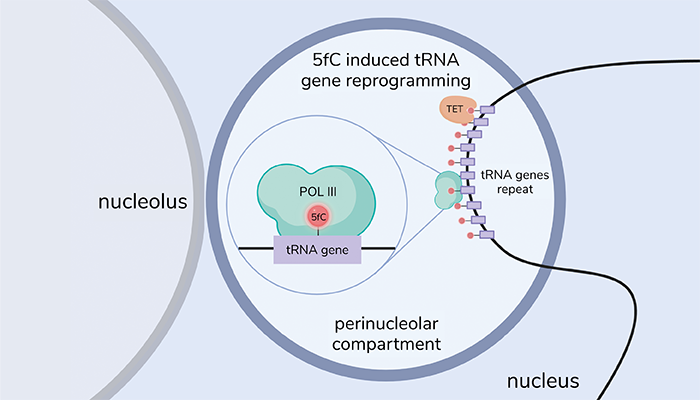
Credit: ill./©: IMB
According to a new study, 5-formylcytosine (5fC), an epigenetic modification previously thought to be a passive byproduct of DNA demethylation, plays a pivotal role in regulating gene transcription during early embryonic development. Researchers have discovered that 5fC helps activate critical tRNA genes by facilitating RNA Polymerase III (Pol III) recruitment during zygotic genome activation (ZGA) in Xenopus and mouse embryos.
ZGA is a key developmental process where an embryo transitions from relying on maternal RNA to producing its own RNA, kickstarting the genetic activity needed for growth. While much of the focus has been on how RNA Polymerase II drives gene expression, this study highlights the importance of Pol III, which is responsible for transcribing transfer RNAs (tRNAs) and other small RNAs crucial for protein synthesis.
Using several techniques, including liquid chromatography-tandem mass spectrometry (LC-MS/MS), DNA immunoprecipitation sequencing (DIP-seq), and chromatin immunoprecipitation sequencing (ChIP-seq), the researchers tracked how 5fC marks specific regions of the genome involved in tRNA transcription. They observed that 5fC accumulates at Pol III target sites, such as tRNA genes, during ZGA, correlating with increased transcriptional activity.
"The observation of 5fC in microscopically visible tiny dots, or chromocenters, was exciting. Based on them, we suspected that 5fC must do something important in early embryonic development," said Eleftheria Parasyraki, the first author of the study, in a press release.
In their analysis, the team found that 5fC facilitates the recruitment of Pol III to these genomic sites, directly influencing the transcription of genes critical for early development. By marking tRNA genes, 5fC plays an essential role in the production of transfer RNAs, molecules that are vital for translating the genetic code into functional proteins during the early stages of life.
The discovery that 5fC is not just a DNA demethylation byproduct but an active participant in gene regulation during embryogenesis represents a significant shift in understanding epigenetic modifications. It underscores the broader impact of these modifications on early developmental processes and potentially in other biological contexts.
"These findings are a real breakthrough in epigenetics because 5fC is only the second proven epigenetic DNA modification besides methylcytosine," said Christof Niehrs, Founding and Scientific Director of the IMB, who led the team.




